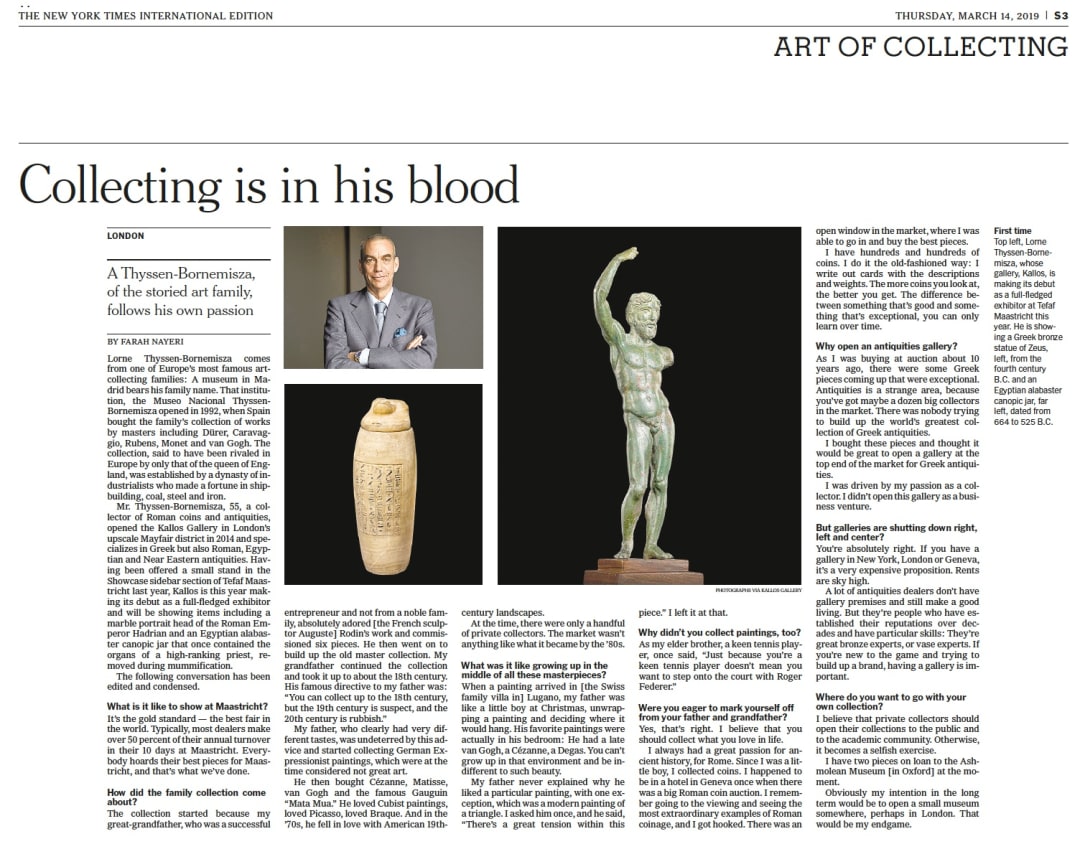The New York Times interview with Baron Thyssen-Bornemisza
- X
- Tumblr
14 March 2019
By Farah Nayeri
Art Collecting Is in His Blood
LONDON — Lorne Thyssen-Bornemisza comes from one of Europe’s most famous art-collecting families: A museum in Madrid bears his family name. That institution, the Museo Nacional Thyssen-Bornemisza opened in 1992, when Spain bought the family’s collection of works by masters including Dürer, Caravaggio, Rubens, Monet and van Gogh. The collection, said to have been rivaled in Europe by only that of the queen of England, was established by a dynasty of industrialists who made a fortune in shipbuilding, coal, steel and iron.
Mr. Thyssen-Bornemisza, 55, a collector of Roman coins and antiquities, opened the Kallos Gallery in London’s upscale Mayfair district in 2014 and specializes in Greek but also Roman, Egyptian and Near Eastern antiquities. Having been offered a small stand in the Showcase sidebar section of Tefaf Maastricht last year, Kallos is this year making its debut as a full-fledged exhibitor and will be showing items including a marble portrait head of the Roman Emperor Hadrian and an Egyptian alabaster canopic jar that once contained the organs of a high-ranking priest, removed during mummification.
The following conversation has been edited and condensed.
What is it like to show at Maastricht?
It’s the gold standard — the best fair in the world. Typically, most dealers make over 50 percent of their annual turnover in their 10 days at Maastricht. Everybody hoards their best pieces for Maastricht, and that’s what we’ve done.
How did the family collection come about?
The collection started because my great-grandfather, who was a successful entrepreneur and not from a noble family, absolutely adored [the French sculptor Auguste] Rodin’s work and commissioned six pieces. He then went on to build up the old master collection. My grandfather continued the collection and took it up to about the 18th century. His famous directive to my father was: “You can collect up to the 18th century, but the 19th century is suspect, and the 20th century is rubbish.”
My father, who clearly had very different tastes, was undeterred by this advice and started collecting German Expressionist paintings, which were at the time considered not great art. He then bought Cézanne, Matisse, van Gogh and the famous Gauguin “Mata Mua.” He loved Cubist paintings, loved Picasso, loved Braque. And in the ’70s, he fell in love with American 19th-century landscapes. At the time, there were only a handful of private collectors. The market wasn’t anything like what it became by the ’80s.
What was it like growing up in the middle of all these masterpieces?
When a painting arrived in [the Swiss family villa in] Lugano, my father was like a little boy at Christmas, unwrapping a painting and deciding where it would hang. His favorite paintings were actually in his bedroom: He had a late van Gogh, a Cézanne, a Degas. You can’t grow up in that environment and be indifferent to such beauty.
My father never explained why he liked a particular painting, with one exception, which was a modern painting of a triangle. I asked him once, and he said, “There’s a great tension within this piece.” I left it at that.
Why didn’t you collect paintings, too?
As my elder brother, a keen tennis player, once said, “Just because you’re a keen tennis player doesn’t mean you want to step onto the court with Roger Federer.”
Were you eager to mark yourself off from your father and grandfather?
Yes, that’s right. I believe that you should collect what you love in life.
I always had a great passion for ancient history, for Rome. Since I was a little boy, I collected coins. I happened to be in a hotel in Geneva once when there was a big Roman coin auction. I remember going to the viewing and seeing the most extraordinary examples of Roman coinage, and I got hooked. There was an open window in the market, where I was able to go in and buy the best pieces.
I have hundreds and hundreds of coins. I do it the old-fashioned way: I write out cards with the descriptions and weights. The more coins you look at, the better you get. The difference between something that’s good and something that’s exceptional, you can only learn over time.
Why open an antiquities gallery?
As I was buying at auction about 10 years ago, there were some Greek pieces coming up that were exceptional. Antiquities is a strange area, because you’ve got maybe a dozen big collectors in the market. There was nobody trying to build up the world’s greatest collection of Greek antiquities.
I bought these pieces and thought it would be great to open a gallery at the top end of the market for Greek antiquities. I was driven by my passion as a collector. I didn’t open this gallery as a business venture.
But galleries are shutting down right, left and center?
You’re absolutely right. If you have a gallery in New York, London or Geneva, it’s a very expensive proposition. Rents are sky high.
A lot of antiquities dealers don’t have gallery premises and still make a good living. But they’re people who have established their reputations over decades and have particular skills: They’re great bronze experts, or vase experts. If you’re new to the game and trying to build up a brand, having a gallery is important.
Where do you want to go with your own collection?
I believe that private collectors should open their collections to the public and to the academic community. Otherwise, it becomes a selfish exercise. I have two pieces on loan to the Ashmolean Museum [in Oxford] at the moment.
Obviously my intention in the long term would be to open a small museum somewhere, perhaps in London. That would be my endgame.
